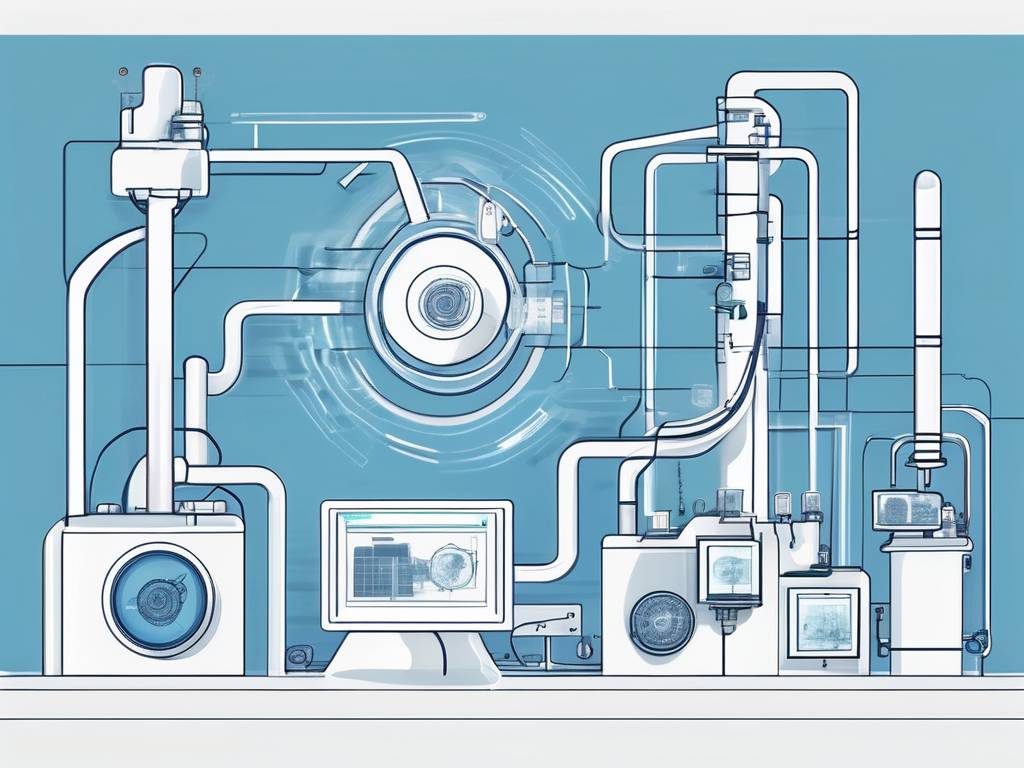Internet of Things (IoT): Internet Of Things Explained
The Internet of Things (IoT) is a rapidly evolving and complex field that encompasses a wide range of technologies, applications, and uses. It refers to the network of physical objects or “things” embedded with sensors, software, and other technologies for the purpose of connecting and exchanging data with other devices and systems over the internet. These devices, ranging from ordinary household objects to sophisticated industrial tools, are set to revolutionize the way we live and work.
IoT is a transformative force that can help to improve efficiencies and increase economic benefits. It has the potential to impact every facet of our lives, from our homes and cars to our health and cities. However, it also presents new challenges in terms of privacy, security, and regulation. This glossary aims to provide a comprehensive understanding of the Internet of Things, its key concepts, applications, and issues.
Concept & Origin of IoT
The concept of IoT is not new. It has its roots in several technologies and trends that have been evolving over the past few decades, including the internet, wireless communication, embedded systems, and micro-electromechanical systems (MEMS). However, it was not until the late 1990s and early 2000s that the term “Internet of Things” was coined and started to gain widespread recognition.
The term “Internet of Things” was first used by British technology pioneer Kevin Ashton in 1999 during his work at Procter & Gamble. Ashton was one of the first to recognize that when everything is connected, the data that these connections generate can be harnessed to create unprecedented efficiencies and insights.
Evolution of IoT
IoT has evolved significantly since its inception. Early IoT applications were primarily in the industrial and business sectors, where machine-to-machine (M2M) communication and automation technologies were already in use. However, with the advent of smartphones, wireless networks, and high-speed internet, IoT has expanded to include consumer applications, transforming everyday objects into smart devices.
Today, IoT is a critical component of the broader digital transformation, enabling businesses to reimagine their operations, create new business models, and offer innovative products and services. It is also increasingly being used to address societal challenges, such as improving healthcare delivery, managing natural resources, and creating smart cities.
Key Concepts in IoT
IoT is a complex field with many interrelated concepts. Some of the key concepts include “things”, which are the physical objects that are connected to the internet; “sensors”, which collect data from the environment; “connectivity”, which refers to the networks that transmit the data; and “applications”, which use the data to provide value.
Another important concept is “interoperability”, which is the ability of different systems and devices to work together. Interoperability is crucial for the functioning of the IoT, as it allows data to flow seamlessly between devices and systems, regardless of their manufacturer or technology. Other important concepts include “security”, “privacy”, and “data management”, which are critical issues in the design and operation of IoT systems.
Applications of IoT
IoT has a wide range of applications, from consumer products to industrial systems. In the consumer sector, IoT is used in smart homes, wearable devices, connected cars, and smart cities. In the industrial sector, IoT is used in manufacturing, agriculture, healthcare, transportation, and energy.
Smart homes are one of the most common applications of IoT. They use connected devices, such as smart thermostats, lights, and security systems, to automate and control various aspects of the home environment. Wearable devices, such as fitness trackers and smartwatches, use sensors to monitor health and fitness data, while connected cars use IoT technologies to enhance safety, efficiency, and comfort.
Industrial IoT (IIoT)
The Industrial Internet of Things (IIoT) is a subfield of IoT that focuses on the use of IoT technologies in industrial settings. IIoT is used to improve operational efficiency, enable predictive maintenance, enhance safety, and create new business models. It is a key component of Industry 4.0, the fourth industrial revolution, which involves the digitization and automation of manufacturing processes.
IIoT uses a variety of technologies, including sensors, robotics, big data, artificial intelligence (AI), and machine learning, to collect, analyze, and act on data in real time. This enables businesses to make more informed decisions, reduce downtime, and increase productivity. However, IIoT also presents unique challenges, such as the need for robust security and the management of large volumes of data.
Smart Cities
Smart cities use IoT technologies to improve the quality of life for their residents, enhance sustainability, and streamline urban services. This includes everything from smart grids and water management systems to intelligent transportation systems and smart buildings. By connecting infrastructure, devices, and people, smart cities can become more efficient, resilient, and responsive to the needs of their citizens.
However, the development of smart cities also raises important questions about privacy, security, and governance. As cities become increasingly connected, they also become more vulnerable to cyberattacks and data breaches. Furthermore, the use of IoT technologies to collect and analyze data about citizens’ behaviors and preferences raises concerns about privacy and data protection.
Challenges & Issues in IoT
While IoT offers many benefits, it also presents a number of challenges and issues. These include technical challenges, such as the need for interoperability, scalability, and reliability; security and privacy issues; and regulatory and ethical considerations.
One of the biggest challenges in IoT is ensuring the security and privacy of the data that is collected and transmitted. IoT devices are often vulnerable to cyberattacks, which can lead to data breaches, disruption of services, and even physical harm. Ensuring the privacy of data is also a major concern, as IoT devices can collect a vast amount of personal and sensitive information.
Technical Challenges
Technical challenges in IoT include the need for interoperability, scalability, and reliability. Interoperability is the ability of different systems and devices to work together, which is crucial for the functioning of the IoT. However, with the wide variety of devices, technologies, and standards in use, achieving interoperability can be difficult.
Scalability is the ability of a system to handle an increasing amount of work, which is important as the number of IoT devices continues to grow. Reliability is the ability of a system to perform its intended function without failure, which is critical for applications where the failure of an IoT device could have serious consequences, such as in healthcare or transportation.
Security & Privacy Issues
Security and privacy are major concerns in IoT. IoT devices are often vulnerable to cyberattacks, which can lead to data breaches, disruption of services, and even physical harm. This is due to a number of factors, including the use of insecure communication protocols, lack of secure update mechanisms, and the use of default or weak passwords.
Privacy is also a major concern, as IoT devices can collect a vast amount of personal and sensitive information. This data can be used to infer a person’s behaviors, preferences, and habits, raising concerns about surveillance and data protection. Ensuring the privacy of data in IoT requires a combination of technical measures, such as encryption and anonymization, and regulatory measures, such as data protection laws and regulations.
Future of IoT
The future of IoT is promising, with new technologies, applications, and uses emerging all the time. Advances in artificial intelligence, machine learning, and big data analytics are expected to drive the next wave of IoT innovation, enabling more intelligent and autonomous systems. However, the future of IoT also presents new challenges and issues, particularly in terms of security, privacy, and regulation.
One of the key trends in the future of IoT is the convergence of IoT with other emerging technologies, such as blockchain, edge computing, and 5G. These technologies can help to address some of the challenges in IoT, such as security and scalability, and open up new possibilities for IoT applications. For example, blockchain can provide a secure and transparent way to track the provenance of goods in a supply chain, while edge computing can reduce the latency and bandwidth requirements of IoT systems.
IoT & Artificial Intelligence
Artificial intelligence (AI) and machine learning are set to play a key role in the future of IoT. AI can be used to analyze the vast amounts of data generated by IoT devices, enabling more intelligent and autonomous systems. This can lead to more efficient operations, improved decision-making, and new insights and innovations.
However, the integration of AI and IoT also presents new challenges and issues. These include the need for robust and explainable AI algorithms, the management of large volumes of data, and the ethical and societal implications of AI. Furthermore, the use of AI in IoT raises important questions about privacy and data protection, as AI algorithms often require access to personal and sensitive data.
Regulation & Ethics in IoT
As IoT continues to evolve, it raises important regulatory and ethical questions. These include questions about privacy and data protection, security, liability, and the impact of IoT on jobs and the economy. Addressing these questions requires a multidisciplinary approach, involving not only technologists and engineers, but also policymakers, legal experts, ethicists, and society at large.
Regulation is a key issue in IoT, as it can help to ensure the security and privacy of data, protect consumers, and promote fair competition. However, regulation can also stifle innovation and create barriers to entry. Balancing these competing interests is a major challenge for policymakers. Ethics is another important issue in IoT, as it involves questions about the responsible use of technology, the impact of IoT on society, and the rights and responsibilities of individuals and organizations.
Conclusion
The Internet of Things is a complex and rapidly evolving field that has the potential to transform our lives and society in profound ways. It offers many benefits, from improving efficiencies and creating new economic opportunities, to addressing societal challenges and enhancing our quality of life. However, it also presents new challenges and issues, particularly in terms of security, privacy, and regulation.

 hello@westlink.com
hello@westlink.com  (866) 954-6533
(866) 954-6533  700 N Colorado Blvd,
700 N Colorado Blvd,







Comments